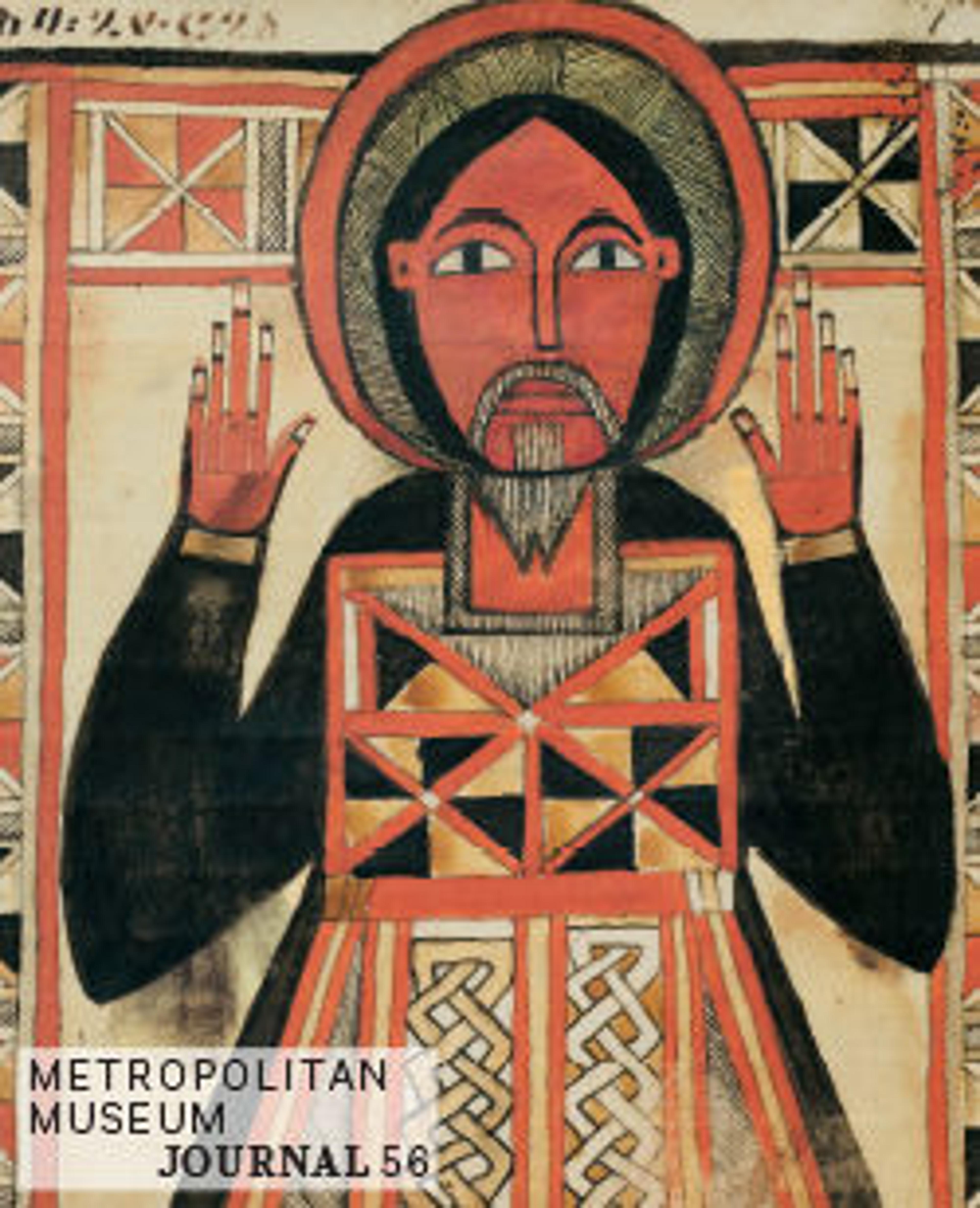Tälsäm or yä bərana kətab (healing scroll)
One of the earliest African objects to enter the Metropolitan’s collection, this Ethiopian scroll was part of a ritual healing process. It was created by a däbtära (an unordained cleric) to rid a person of physical illness caused by malevolent spirits. The parchment scroll is composed of three alternating panels of talismanic imagery and prayers selected according to the client’s zodiac sign. While däbtäras draw from a common pool of motifs to create scrolls, there is no fixed symbolic interpretation for any one talismanic design.
The upper and lower motifs are both variations on eight-pointed stars. Interpreted as the "Sea; of Solomon," gätsä säb’e ("face of man"), or an eight-winged angel, the motif is among the most common in Ethiopian scrolls. The upper talisman precedes the prayer to Saint Susenyos, who was invoked in scrolls intended for women. In the central panel, a large man wearing a white and ocher robe sprinkled with orange stars holds a horned beast aloft in his left hand. This scene has variously been interpreted as Abraham and Isaac with the sacrificial lamb, or as the archangel Phanuel alongside the scroll’s owner, Hayla-Mikáel. Given the prayer to Phanuel at the base of the scroll and the central figure’s wings and sword, the latter is more likely. The animal—a horned brown demon—has been depicted with one visible eye, an Ethiopian convention for depicting evil.
The extreme length of this scroll—nearly six and a half feet—and the depiction of the archangel Phanuel in its central panel indicate that it was hung in a home. When displayed opposite a door, talismanic angels threatened any spirits who tried to enter.
Kristen Windmuller-Luna, 2015
The upper and lower motifs are both variations on eight-pointed stars. Interpreted as the "Sea; of Solomon," gätsä säb’e ("face of man"), or an eight-winged angel, the motif is among the most common in Ethiopian scrolls. The upper talisman precedes the prayer to Saint Susenyos, who was invoked in scrolls intended for women. In the central panel, a large man wearing a white and ocher robe sprinkled with orange stars holds a horned beast aloft in his left hand. This scene has variously been interpreted as Abraham and Isaac with the sacrificial lamb, or as the archangel Phanuel alongside the scroll’s owner, Hayla-Mikáel. Given the prayer to Phanuel at the base of the scroll and the central figure’s wings and sword, the latter is more likely. The animal—a horned brown demon—has been depicted with one visible eye, an Ethiopian convention for depicting evil.
The extreme length of this scroll—nearly six and a half feet—and the depiction of the archangel Phanuel in its central panel indicate that it was hung in a home. When displayed opposite a door, talismanic angels threatened any spirits who tried to enter.
Kristen Windmuller-Luna, 2015
Artwork Details
- Title: Tälsäm or yä bərana kətab (healing scroll)
- Artist: Northern Highlands däbtära (religious scholar)
- Date: 19th century
- Geography: Ethiopia
- Culture: Amhara or Tigrinya peoples
- Medium: Parchment (vellum), pigment
- Dimensions: W. 6 x L. 78 in. (15.24 x 198.12 cm)
- Classification: Hide-Documents
- Credit Line: Museum Purchase, transferred from the Library
- Object Number: 95.66
- Curatorial Department: The Michael C. Rockefeller Wing
More Artwork
Research Resources
The Met provides unparalleled resources for research and welcomes an international community of students and scholars. The Met's Open Access API is where creators and researchers can connect to the The Met collection. Open Access data and public domain images are available for unrestricted commercial and noncommercial use without permission or fee.
To request images under copyright and other restrictions, please use this Image Request form.
Feedback
We continue to research and examine historical and cultural context for objects in The Met collection. If you have comments or questions about this object record, please contact us using the form below. The Museum looks forward to receiving your comments.
